PPL SUZUKI SX4 2006 1.G Service Owners Manual
[x] Cancel search | Manufacturer: SUZUKI, Model Year: 2006, Model line: SX4, Model: SUZUKI SX4 2006 1.GPages: 1556, PDF Size: 37.31 MB
Page 323 of 1556
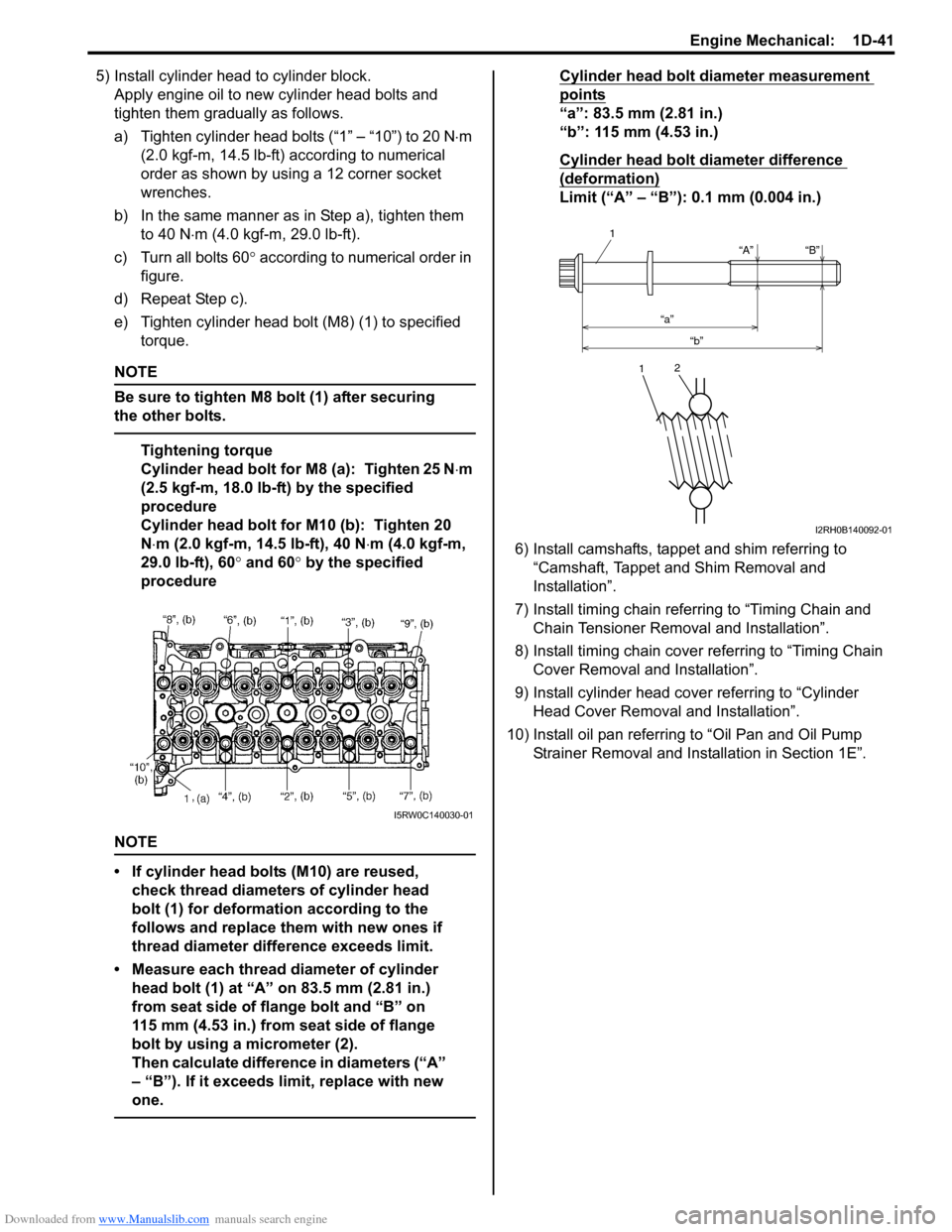
Downloaded from www.Manualslib.com manuals search engine Engine Mechanical: 1D-41
5) Install cylinder head to cylinder block.
Apply engine oil to new cylinder head bolts and
tighten them gradually as follows.
a) Tighten cylinder head bolts (“1” – “10”) to 20 N⋅m
(2.0 kgf-m, 14.5 lb-ft) according to numerical
order as shown by using a 12 corner socket
wrenches.
b) In the same manner as in Step a), tighten them
to 40 N⋅m (4.0 kgf-m, 29.0 lb-ft).
c) Turn all bolts 60° according to numerical order in
figure.
d) Repeat Step c).
e) Tighten cylinder head bolt (M8) (1) to specified
torque.
NOTE
Be sure to tighten M8 bolt (1) after securing
the other bolts.
Tightening torque
Cylinder head bolt for M8 (a): Tighten 25 N⋅m
(2.5 kgf-m, 18.0 lb-ft) by the specified
procedure
Cylinder head bolt for M10 (b): Tighten 20
N⋅m (2.0 kgf-m, 14.5 lb-ft), 40 N⋅m (4.0 kgf-m,
29.0 lb-ft), 60° and 60° by the specified
procedure
NOTE
• If cylinder head bolts (M10) are reused,
check thread diameters of cylinder head
bolt (1) for deformation according to the
follows and replace them with new ones if
thread diameter difference exceeds limit.
• Measure each thread diameter of cylinder
head bolt (1) at “A” on 83.5 mm (2.81 in.)
from seat side of flange bolt and “B” on
115 mm (4.53 in.) from seat side of flange
bolt by using a micrometer (2).
Then calculate difference in diameters (“A”
– “B”). If it exceeds limit, replace with new
one.
Cylinder head bolt diameter measurement
points
“a”: 83.5 mm (2.81 in.)
“b”: 115 mm (4.53 in.)
Cylinder head bolt diameter difference
(deformation)
Limit (“A” – “B”): 0.1 mm (0.004 in.)
6) Install camshafts, tappet and shim referring to
“Camshaft, Tappet and Shim Removal and
Installation”.
7) Install timing chain referring to “Timing Chain and
Chain Tensioner Removal and Installation”.
8) Install timing chain cover referring to “Timing Chain
Cover Removal and Installation”.
9) Install cylinder head cover referring to “Cylinder
Head Cover Removal and Installation”.
10) Install oil pan referring to “Oil Pan and Oil Pump
Strainer Removal and Installation in Section 1E”.
I5RW0C140030-01
“A”
“a”
“b”“B”
1
12
I2RH0B140092-01
Page 325 of 1556
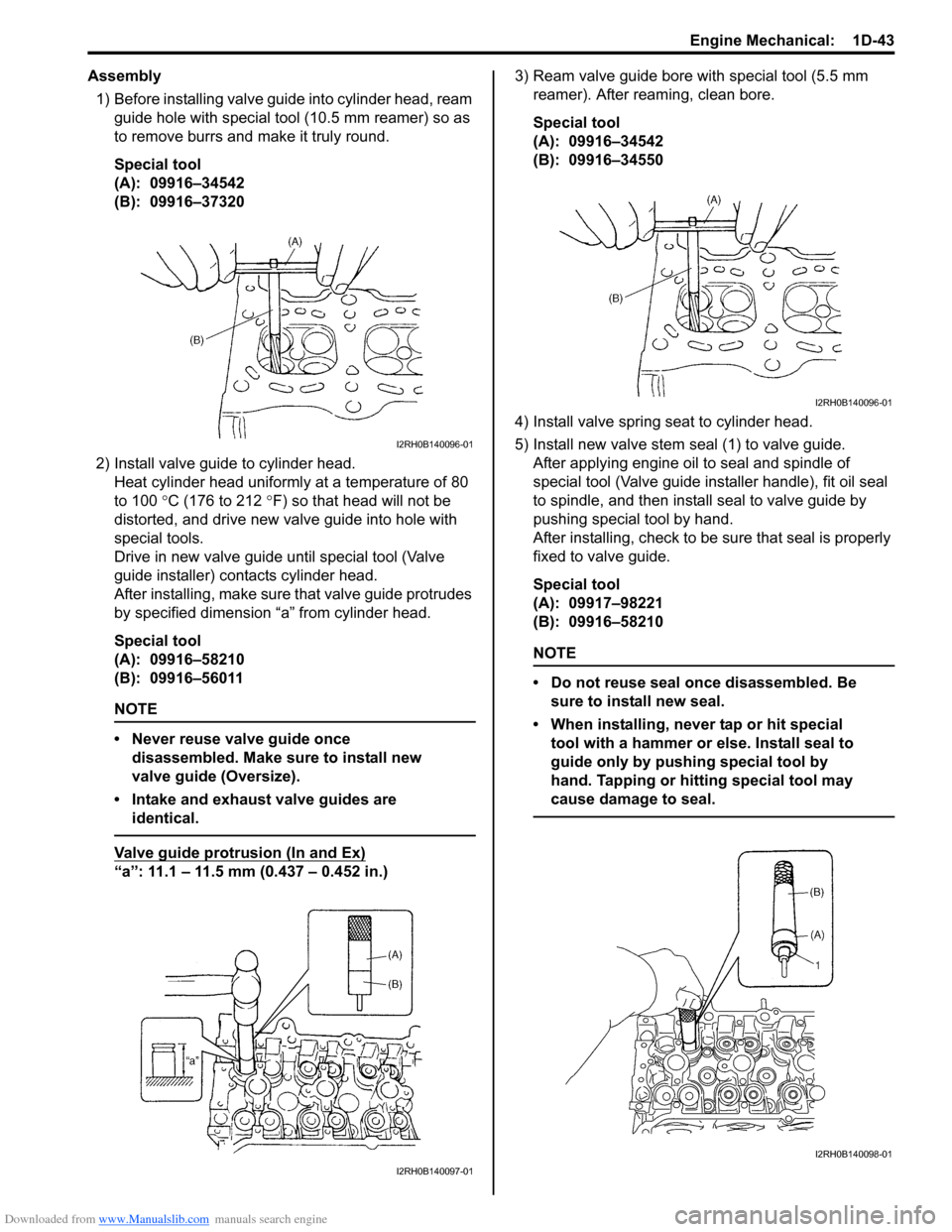
Downloaded from www.Manualslib.com manuals search engine Engine Mechanical: 1D-43
Assembly
1) Before installing valve guide into cylinder head, ream
guide hole with special tool (10.5 mm reamer) so as
to remove burrs and make it truly round.
Special tool
(A): 09916–34542
(B): 09916–37320
2) Install valve guide to cylinder head.
Heat cylinder head uniformly at a temperature of 80
to 100 °C (176 to 212 °F) so that head will not be
distorted, and drive new valve guide into hole with
special tools.
Drive in new valve guide until special tool (Valve
guide installer) contacts cylinder head.
After installing, make sure that valve guide protrudes
by specified dimension “a” from cylinder head.
Special tool
(A): 09916–58210
(B): 09916–56011
NOTE
• Never reuse valve guide once
disassembled. Make sure to install new
valve guide (Oversize).
• Intake and exhaust valve guides are
identical.
Valve guide protrusion (In and Ex)
“a”: 11.1 – 11.5 mm (0.437 – 0.452 in.)3) Ream valve guide bore with special tool (5.5 mm
reamer). After reaming, clean bore.
Special tool
(A): 09916–34542
(B): 09916–34550
4) Install valve spring seat to cylinder head.
5) Install new valve stem seal (1) to valve guide.
After applying engine oil to seal and spindle of
special tool (Valve guide installer handle), fit oil seal
to spindle, and then install seal to valve guide by
pushing special tool by hand.
After installing, check to be sure that seal is properly
fixed to valve guide.
Special tool
(A): 09917–98221
(B): 09916–58210
NOTE
• Do not reuse seal once disassembled. Be
sure to install new seal.
• When installing, never tap or hit special
tool with a hammer or else. Install seal to
guide only by pushing special tool by
hand. Tapping or hitting special tool may
cause damage to seal.
I2RH0B140096-01
I2RH0B140097-01
I2RH0B140096-01
I2RH0B140098-01
Page 326 of 1556
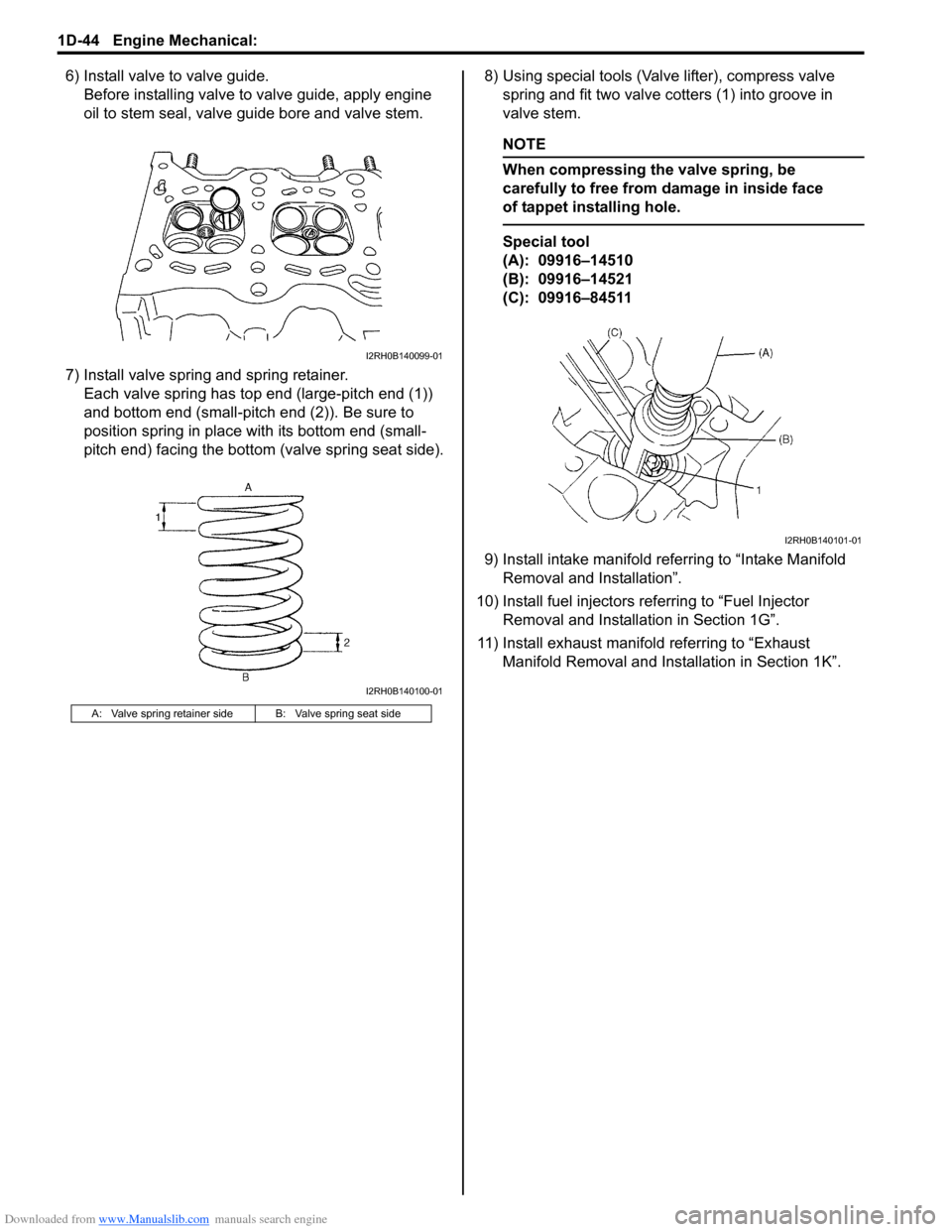
Downloaded from www.Manualslib.com manuals search engine 1D-44 Engine Mechanical:
6) Install valve to valve guide.
Before installing valve to valve guide, apply engine
oil to stem seal, valve guide bore and valve stem.
7) Install valve spring and spring retainer.
Each valve spring has top end (large-pitch end (1))
and bottom end (small-pitch end (2)). Be sure to
position spring in place with its bottom end (small-
pitch end) facing the bottom (valve spring seat side).8) Using special tools (Valve lifter), compress valve
spring and fit two valve cotters (1) into groove in
valve stem.
NOTE
When compressing the valve spring, be
carefully to free from damage in inside face
of tappet installing hole.
Special tool
(A): 09916–14510
(B): 09916–14521
(C): 09916–84511
9) Install intake manifold referring to “Intake Manifold
Removal and Installation”.
10) Install fuel injectors referring to “Fuel Injector
Removal and Installation in Section 1G”.
11) Install exhaust manifold referring to “Exhaust
Manifold Removal and Installation in Section 1K”.
A: Valve spring retainer side B: Valve spring seat side
I2RH0B140099-01
I2RH0B140100-01
I2RH0B140101-01
Page 328 of 1556
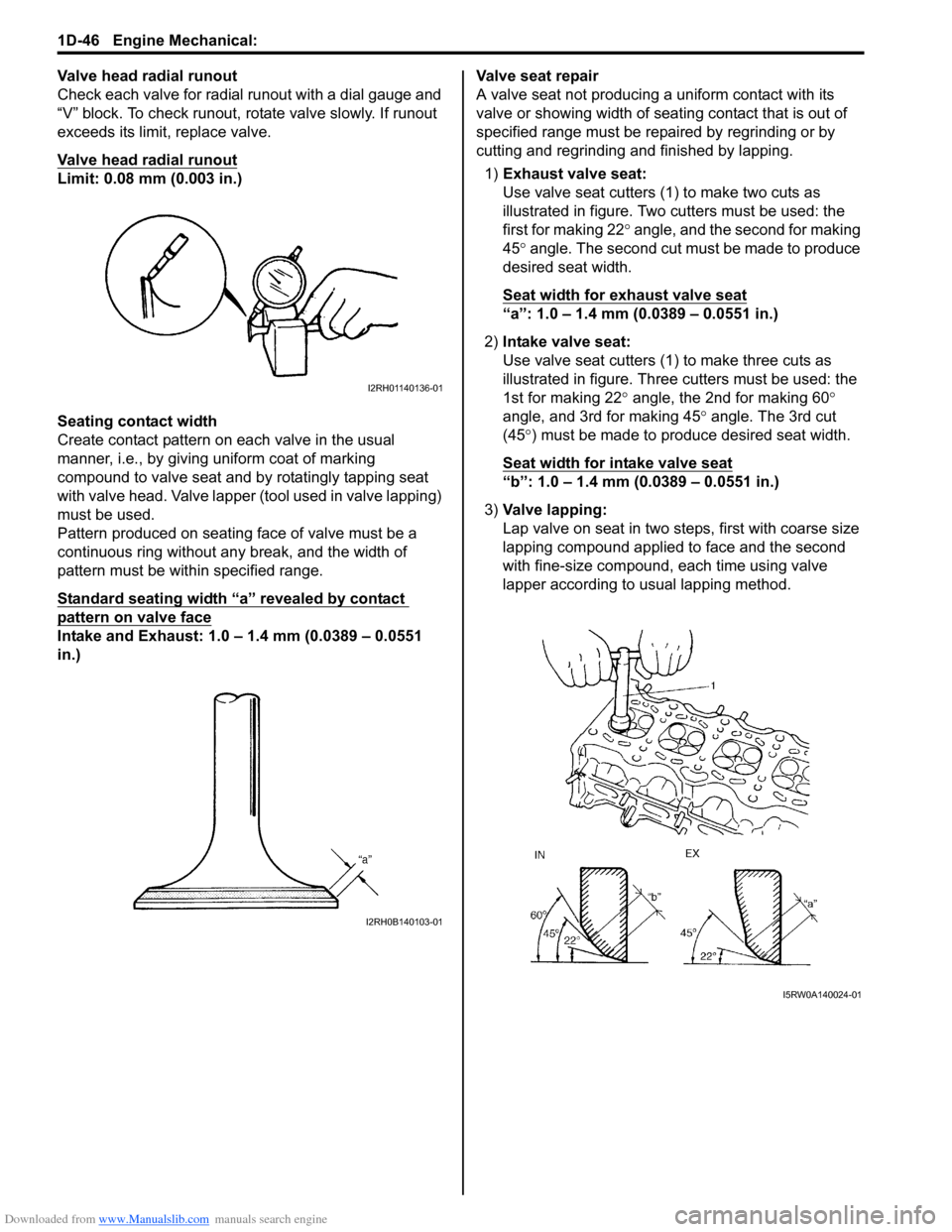
Downloaded from www.Manualslib.com manuals search engine 1D-46 Engine Mechanical:
Valve head radial runout
Check each valve for radial runout with a dial gauge and
“V” block. To check runout, rotate valve slowly. If runout
exceeds its limit, replace valve.
Valve head radial runout
Limit: 0.08 mm (0.003 in.)
Seating contact width
Create contact pattern on each valve in the usual
manner, i.e., by giving uniform coat of marking
compound to valve seat and by rotatingly tapping seat
with valve head. Valve lapper (tool used in valve lapping)
must be used.
Pattern produced on seating face of valve must be a
continuous ring without any break, and the width of
pattern must be within specified range.
Standard seating width “a” revealed by contact
pattern on valve face
Intake and Exhaust: 1.0 – 1.4 mm (0.0389 – 0.0551
in.)Valve seat repair
A valve seat not producing a uniform contact with its
valve or showing width of seating contact that is out of
specified range must be repaired by regrinding or by
cutting and regrinding and finished by lapping.
1)Exhaust valve seat:
Use valve seat cutters (1) to make two cuts as
illustrated in figure. Two cutters must be used: the
first for making 22° angle, and the second for making
45° angle. The second cut must be made to produce
desired seat width.
Seat width for exhaust valve seat
“a”: 1.0 – 1.4 mm (0.0389 – 0.0551 in.)
2)Intake valve seat:
Use valve seat cutters (1) to make three cuts as
illustrated in figure. Three cutters must be used: the
1st for making 22° angle, the 2nd for making 60°
angle, and 3rd for making 45° angle. The 3rd cut
(45°) must be made to produce desired seat width.
Seat width for intake valve seat
“b”: 1.0 – 1.4 mm (0.0389 – 0.0551 in.)
3)Valve lapping:
Lap valve on seat in two steps, first with coarse size
lapping compound applied to face and the second
with fine-size compound, each time using valve
lapper according to usual lapping method.
I2RH01140136-01
I2RH0B140103-01
I5RW0A140024-01
Page 329 of 1556
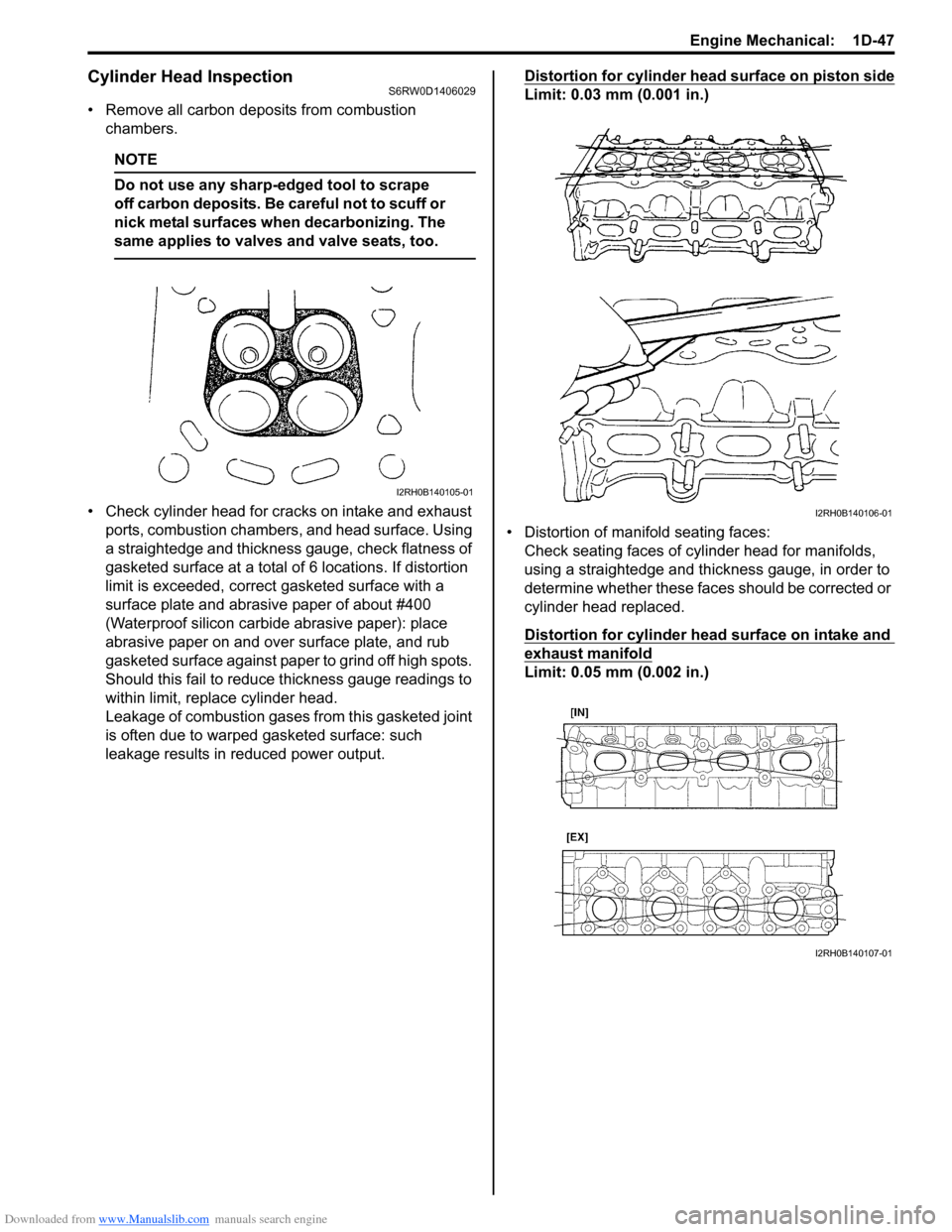
Downloaded from www.Manualslib.com manuals search engine Engine Mechanical: 1D-47
Cylinder Head InspectionS6RW0D1406029
• Remove all carbon deposits from combustion
chambers.
NOTE
Do not use any sharp-edged tool to scrape
off carbon deposits. Be careful not to scuff or
nick metal surfaces when decarbonizing. The
same applies to valves and valve seats, too.
• Check cylinder head for cracks on intake and exhaust
ports, combustion chambers, and head surface. Using
a straightedge and thickness gauge, check flatness of
gasketed surface at a total of 6 locations. If distortion
limit is exceeded, correct gasketed surface with a
surface plate and abrasive paper of about #400
(Waterproof silicon carbide abrasive paper): place
abrasive paper on and over surface plate, and rub
gasketed surface against paper to grind off high spots.
Should this fail to reduce thickness gauge readings to
within limit, replace cylinder head.
Leakage of combustion gases from this gasketed joint
is often due to warped gasketed surface: such
leakage results in reduced power output.Distortion for cylinder head surface on piston side
Limit: 0.03 mm (0.001 in.)
• Distortion of manifold seating faces:
Check seating faces of cylinder head for manifolds,
using a straightedge and thickness gauge, in order to
determine whether these faces should be corrected or
cylinder head replaced.
Distortion for cylinder head surface on intake and
exhaust manifold
Limit: 0.05 mm (0.002 in.)
I2RH0B140105-01
I2RH0B140106-01
I2RH0B140107-01
Page 331 of 1556

Downloaded from www.Manualslib.com manuals search engine Engine Mechanical: 1D-49
Pistons, Piston Rings, Connecting Rods and Cylinders ComponentsS6RW0D1406031
Pistons, Piston Rings, Connecting Rods and
Cylinders Removal and Installation
S6RW0D1406032
Removal
1) Remove engine assembly from vehicle referring to
“Engine Assembly Removal and Installation”.
2) Remove cylinder head referring to “Valves and
Cylinder Head Removal and Installation”.
3) Mark cylinder number on all pistons, connecting rods
and connecting rod caps using silver pencil or quick
drying paint.
4) Remove rod bearing caps.
5) Install guide hose (1) over threads of rod bolts.
This prevents damage to crank pin and rod bolt
threads when removing connecting rod.6) Decarbonize top of cylinder bore before removing
piston from cylinder.
7) Push piston and connecting rod assembly out
through the top of cylinder bore.
1. Top ring 8. Piston pin
2. 2nd ring 9. Piston pin circlip
3. Oil ring 10. Bearing cap nut
4. Piston : Tighten 15 N⋅m (1.5 kgf-m, 11.0 lb-ft), 45° and 45° by the specified procedure.
5. Connecting rod
: See “A”: Apply engine oil to sliding surface of each part.
6. Connecting rod bearing cap
: See “B”: Do not reuse.
7. Connecting rod bearing
: See “C”
“A”: Apply engine oil to sliding surface except inner surface of big end, and rod bolts. Make sure rod bolt diameter when reuse it due to plastic deformation
tightening. Refer to “Piston Pins and Connecting Rods Inspection”.
“B”: Point arrow mark on cap to crankshaft pulley side.
“C”: Do not apply oil between connecting rod and bearing or between bearing cap and bearing.
I5RW0C140045-01
I2RH0B140109-01
Page 332 of 1556
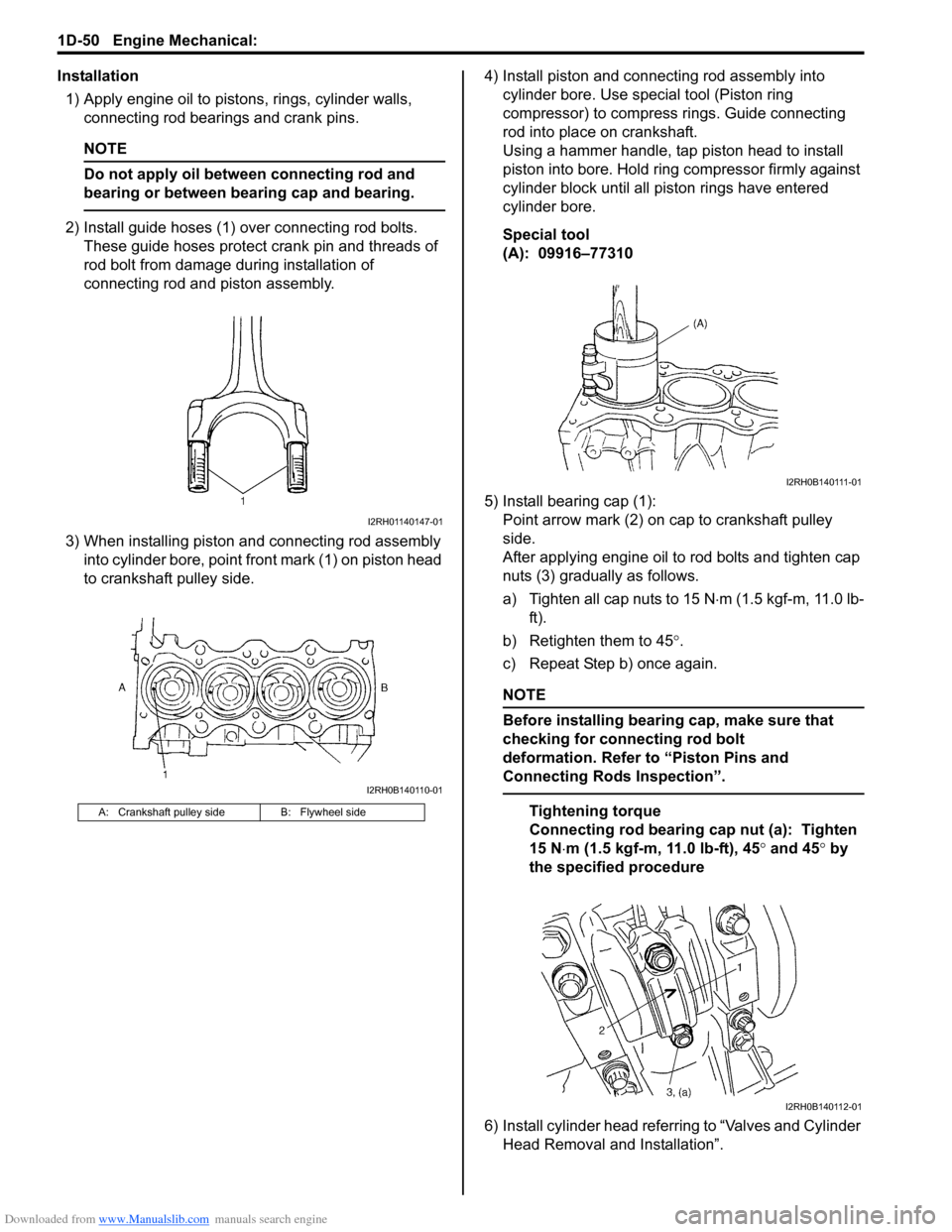
Downloaded from www.Manualslib.com manuals search engine 1D-50 Engine Mechanical:
Installation
1) Apply engine oil to pistons, rings, cylinder walls,
connecting rod bearings and crank pins.
NOTE
Do not apply oil between connecting rod and
bearing or between bearing cap and bearing.
2) Install guide hoses (1) over connecting rod bolts.
These guide hoses protect crank pin and threads of
rod bolt from damage during installation of
connecting rod and piston assembly.
3) When installing piston and connecting rod assembly
into cylinder bore, point front mark (1) on piston head
to crankshaft pulley side.4) Install piston and connecting rod assembly into
cylinder bore. Use special tool (Piston ring
compressor) to compress rings. Guide connecting
rod into place on crankshaft.
Using a hammer handle, tap piston head to install
piston into bore. Hold ring compressor firmly against
cylinder block until all piston rings have entered
cylinder bore.
Special tool
(A): 09916–77310
5) Install bearing cap (1):
Point arrow mark (2) on cap to crankshaft pulley
side.
After applying engine oil to rod bolts and tighten cap
nuts (3) gradually as follows.
a) Tighten all cap nuts to 15 N⋅m (1.5 kgf-m, 11.0 lb-
ft).
b) Retighten them to 45°.
c) Repeat Step b) once again.
NOTE
Before installing bearing cap, make sure that
checking for connecting rod bolt
deformation. Refer to “Piston Pins and
Connecting Rods Inspection”.
Tightening torque
Connecting rod bearing cap nut (a): Tighten
15 N⋅m (1.5 kgf-m, 11.0 lb-ft), 45° and 45° by
the specified procedure
6) Install cylinder head referring to “Valves and Cylinder
Head Removal and Installation”.A: Crankshaft pulley side B: Flywheel side
I2RH01140147-01
I2RH0B140110-01
I2RH0B140111-01
I2RH0B140112-01
Page 333 of 1556

Downloaded from www.Manualslib.com manuals search engine Engine Mechanical: 1D-51
Pistons, Piston Rings, Connecting Rods and
Cylinders Disassembly and Assembly
S6RW0D1406033
Disassembly
1) Using piston ring expander, remove two
compression rings (Top and 2nd) and oil ring from
piston.
2) Remove piston pin from connecting rod as follows.
a) Ease out piston pin circlips (1), as shown.
b) Force piston pin out.
Assembly
1) Decarbonize piston head and ring grooves using a
suitable tool.
2) Install piston pin to piston (1) and connecting rod (2):
a) After applying engine oil to piston pin and piston
pin holes in piston and connecting rod.
b) Installing connecting rod to piston.
NOTE
Be sure to position front mark (4) on piston
and oil hall (5) of connecting rod at specified
position as shown in figure.
c) Insert piston pin to piston and connecting rod.
d) Install piston pin circlips (3).
NOTE
Circlip should be installed with its cut part
facing as shown in figure. Install so that
circlip end gap comes within such range as
indicated by arrow.
3) Install piston rings to piston:
• As indicated in figure, 1st and 2nd rings have “T”
mark (4) respectively. When installing these piston
rings to piston, direct marked side of each ring
toward top of piston.
• 1st ring (1) differs from 2nd ring (2) in thickness,
shape and color of surface contacting cylinder
wall.
Distinguish 1st ring from 2nd ring by referring to
the figure.
• When installing oil ring (3), install spacer first and
then two rails.
4) After installing three rings (1st, 2nd and oil rings),
distribute their end gaps as shown in figure.
I2RH0B140113-01
I2RH0B140114-01
1. Front mark 4. Oil ring upper rail gap
2. 1st ring end gap 5. Oil ring lower rail gap
3. 2nd ring end gap and oil ring spacer gap
I5RW0C140026-01
I6RW0B140011-01
I5RW0C140046-01
Page 338 of 1556

Downloaded from www.Manualslib.com manuals search engine 1D-56 Engine Mechanical:
Connecting Rod Bearing General Information
Service connecting rod bearings are available in
standard size and 0.25 mm (0.0098 in.) undersize
bearing, and standard size bearing has 5 kinds of
bearings differing in tolerance.
For identification of undersize bearing, it is painted red at
the position as indicated in figure, undersize bearing
thickness is 1.605 – 1.615 mm (0.0632 – 0.0635 in.) at
the center of it.
Connecting Rod Bearing Visual Inspection
Inspect bearing shells for signs of fusion, pitting, burn or
flaking and observe contact pattern. Bearing shells
found in defective condition must be replaced.
Connecting Rod Bearing Clearance
1) Before checking bearing clearance, clean bearing
and crank pin.
2) Install bearing in connecting rod and bearing cap.
3) Place a piece of gauging plastic (1) to full width of
crank pin as contacted by bearing (parallel to
crankshaft), avoiding oil hole.4) Install rod bearing cap (1) to connecting rod.
When installing cap, be sure to point arrow mark (2)
on cap to crankshaft pulley side, as shown in figure.
After applying engine oil to rod bolts, tighten cap nuts
(3) gradually as follows.
a) Tighten all cap nuts to 15 N⋅m (1.5 kgf-m, 11.0 lb-
ft)
b) Retighten them to 45°
c) Repeat Step b) once again.
Tightening torque
Connecting rod bearing cap nut (a): Tighten
15 N⋅m (1.5 kgf-m, 11.0 lb-ft) 45° and 45° by
the specified procedure
5) Remove cap and using a scale (1) on gauging
plastic envelope (2), measure gauging plastic (2)
width at the widest point (clearance).
If clearance exceed its limit, use a new standard size
bearing referring to “Selection of Connecting Rod
Bearings: ”.
After selecting new bearing, recheck clearance.
Connecting rod bearing clearance
Standard: 0.029 – 0.047 mm (0.0011 – 0.0018 in.)
Limit: 0.065 mm (0.0026 in.)
6) If clearance can not be brought to its limit even by
using a new standard size bearing, use next thicker
bearing and recheck clearance or regrind crank pin
to undersize and use 0.25 mm undersize bearing.
1. Red paint
I2RH01140164-01
I2RH0B140121-01
I2RH0B140122-01
I2RH0B140123-01
Page 342 of 1556
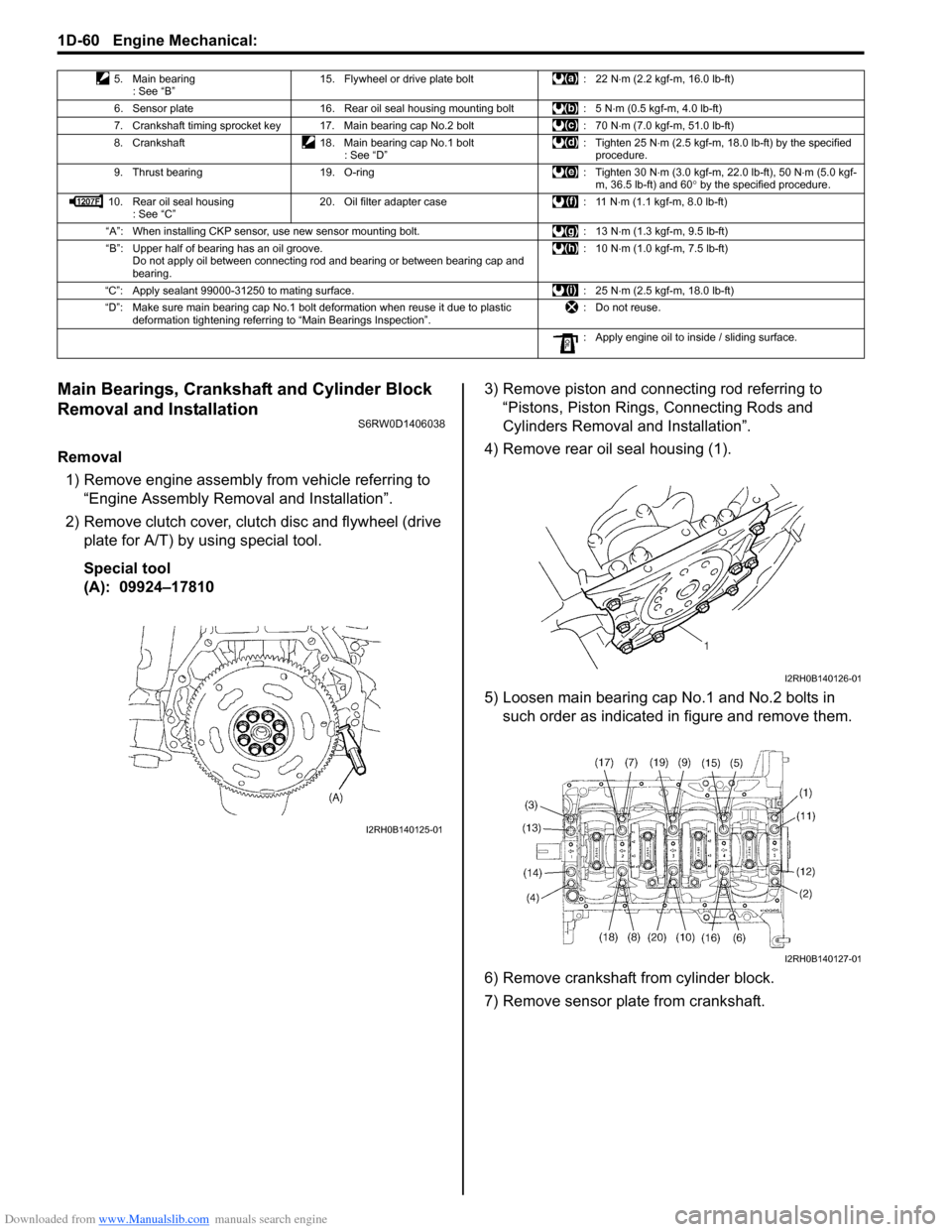
Downloaded from www.Manualslib.com manuals search engine 1D-60 Engine Mechanical:
Main Bearings, Crankshaft and Cylinder Block
Removal and Installation
S6RW0D1406038
Removal
1) Remove engine assembly from vehicle referring to
“Engine Assembly Removal and Installation”.
2) Remove clutch cover, clutch disc and flywheel (drive
plate for A/T) by using special tool.
Special tool
(A): 09924–178103) Remove piston and connecting rod referring to
“Pistons, Piston Rings, Connecting Rods and
Cylinders Removal and Installation”.
4) Remove rear oil seal housing (1).
5) Loosen main bearing cap No.1 and No.2 bolts in
such order as indicated in figure and remove them.
6) Remove crankshaft from cylinder block.
7) Remove sensor plate from crankshaft.
5. Main bearing
: See “B”15. Flywheel or drive plate bolt : 22 N⋅m (2.2 kgf-m, 16.0 lb-ft)
6. Sensor plate 16. Rear oil seal housing mounting bolt : 5 N⋅m (0.5 kgf-m, 4.0 lb-ft)
7. Crankshaft timing sprocket key 17. Main bearing cap No.2 bolt : 70 N⋅m (7.0 kgf-m, 51.0 lb-ft)
8. Crankshaft 18. Main bearing cap No.1 bolt
: See “D”: Tighten 25 N⋅m (2.5 kgf-m, 18.0 lb-ft) by the specified
procedure.
9. Thrust bearing 19. O-ring : Tighten 30 N⋅m (3.0 kgf-m, 22.0 lb-ft), 50 N⋅m (5.0 kgf-
m, 36.5 lb-ft) and 60° by the specified procedure.
10. Rear oil seal housing
: See “C”20. Oil filter adapter case : 11 N⋅m (1.1 kgf-m, 8.0 lb-ft)
“A”: When installing CKP sensor, use new sensor mounting bolt. : 13 N⋅m (1.3 kgf-m, 9.5 lb-ft)
“B”: Upper half of bearing has an oil groove.
Do not apply oil between connecting rod and bearing or between bearing cap and
bearing.:10 N⋅m (1.0 kgf-m, 7.5 lb-ft)
“C”: Apply sealant 99000-31250 to mating surface. : 25 N⋅m (2.5 kgf-m, 18.0 lb-ft)
“D”: Make sure main bearing cap No.1 bolt deformation when reuse it due to plastic
deformation tightening referring to “Main Bearings Inspection”.: Do not reuse.
: Apply engine oil to inside / sliding surface.
I2RH0B140125-01
I2RH0B140126-01
I2RH0B140127-01